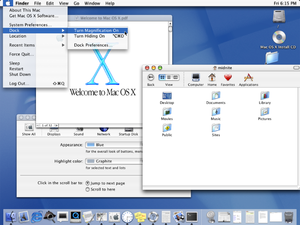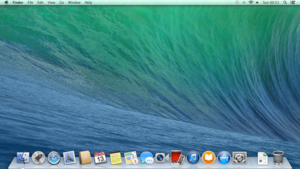About Macintosh (MAC) OS
Operating Systems
Mac OS
In 1984, Apple debuted the operating system that is now known as the "Classic" Mac OS with its release of the original Macintosh System Software. The system, rebranded "Mac OS" in 1996, was preinstalled on every Macintosh until 2002 and offered on Macintosh clones for a short time in the 1990s. Noted for its ease of use, it was also criticized for its lack of modern technologies compared to its competitors.
The current Mac operating system is macOS, originally named "Mac OS X" until 2012 and then "OS X" until 2016. Developed between 1997 and 2001 after Apple's purchase of NeXT, Mac OS X brought an entirely new architecture based on NeXTSTEP, a Unix system, that eliminated many of the technical challenges that faced the classic Mac OS. The current macOS is preinstalled with every Mac and is updated annuallyIt is the basis of Apple's current system software for its other devices, iOS, watchOS, and tvOS.Prior to the introduction of Mac OS X, Apple experimented with several other concepts, releasing different products designed to bring the Macintosh interface or applications to Unix-like systems or vice versa, A/UX, MAE, and MkLinux. Apple's effort to expand upon and develop a replacement for its classic Mac OS in the 1990s led to a few cancelled projects, code named Star Trek, Taligent, and Copland.
Although they have different architectures, the Macintosh operating systems share a common set of GUI principles, including a menu bar across the top of the screen; the Finder shell, featuring a desktop metaphor that represents files and applications using icons and relates concepts like directories and file deletion to real-world objects like folders and a trash can; and overlapping windows for multitasking. The Macintosh is credited with having popularized this concept.
Classic Mac OS
Apple released the original Macintosh on January 24, 1984; its early system software was partially based on the Lisa OS and the Xerox PARC Alto computer, which former Apple CEO Steve Jobs previewed. It was originally named "System Software", or simply "System"; Apple rebranded it as "Mac OS" in 1996 due in part to its Macintosh clone program that ended a year later.Mac OS is characterized by its monolithic system. It was noted as easy to use and featured cooperative multitasking for most of its history, but it was criticized for its limited memory management, lack of protected memory and access controls, and susceptibility to conflicts among extensions.
Releases
Nine major versions of the classic Mac OS were released. The name "Classic" that now signifies the system as a whole is a reference to a compatibility layer that helped ease the transition to Mac OS X.- Macintosh System Software – "System 1", released in 1984
- System Software 2, 3, and 4 – released between 1985 and 1987
- System Software 5 – released in 1987
- System Software 6 – released in 1988
- System 7 – released in 1991
- Mac OS 8 – released in 1997
- Mac OS 9 – final major version, released in 1999
Mac OS X/OS X/macOS
 |
| Logo |
Mac OS X 10.0, released in 2001
macOS Sierra, released in 2016
is the current Mac operating system that officially succeeded the classic Mac OS in 2001.
Although the system was originally marketed as simply "version 10" of Mac OS, it has a history that's largely independent of the classic Mac OS. It is a Unix-based operating system
built on NeXTSTEP and other technology developed at NeXT from the late 1980s until early 1997, when Apple purchased the company and its CEO Steve Jobs returned to Apple.Precursors to the original release of Mac OS X include OpenStep, Apple's Rhapsody project, and the Mac OS X Public Beta.
macOS makes use of the BSD codebase and the XNU kernel,
and its core set of components is based upon Apple's open source Darwin operating system.
Desktop
The first desktop version of the system was released on March 24, 2001, supporting the Aqua user interface. Since then, several more versions adding newer features and technologies have been released. Since 2011, new releases have been offered on an annual basis.- Mac OS X 10.0 – code name "Cheetah", released in 2001
- Mac OS X 10.1 – code name "Puma", released in 2001
- Mac OS X 10.2 – also marketed as "Jaguar", released in 2002
- Mac OS X Panther – version 10.3, released in 2003
- Mac OS X Tiger – version 10.4, released in 2005
- Mac OS X Leopard – version 10.5, released in 2007
- Mac OS X Snow Leopard – version 10.6, released in 2009
- Mac OS X Lion – version 10.7, released in 2011
- OS X Mountain Lion – version 10.8, released in 2012
- OS X Mavericks – version 10.9, released in 2013
- OS X Yosemite – version 10.10, released in 2014
- OS X El Capitan – version 10.11, released in 2015
- macOS Sierra – version 10.12, released in 2016
Server
An early server computing version of the system was released in 1999 as a technology preview. It was followed by several more official server-based releases. Server functionality has instead been offered as an add-on for the desktop system since 2011.- Mac OS X Server 1.0 – code name "Hera", released in 1999
- macOS Server – several releases since 2001
Popular Uploads:
- Mac OS 10.11: EL Captain
- Mac OS 10.7: Tiger
- Mac OS 10.12: Sierra
Thanks For Reading My Post





Comments
Post a Comment